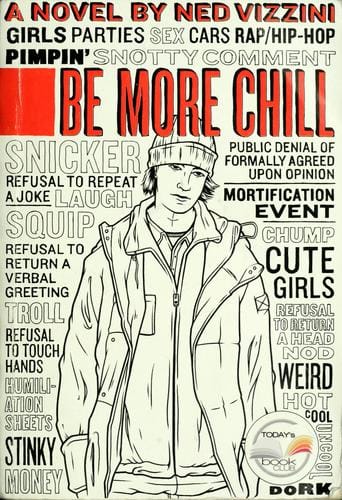Be More Chill: The Ultimate 800-Word Guide
Explore the plot, music, themes and cultural impact of Be More Chill, the cult-favorite novel-turned-musical inspiring fans to embrace their inner weird.

What Is Be More Chill?
Be More Chill began life as Ned Vizzini’s 2004 young-adult novel about Jeremy Heere, an anxious New Jersey teen who swallows a supercomputer pill called a SQUIP (Super Quantum Unit Intel Processor) to become popular. A decade later the story mutated into a boundary-pushing musical by composer Joe Iconis and book writer Joe Tracz. After a modest regional premiere in 2015, a viral cast album rocketed the show to off-Broadway and ultimately Broadway in 2019, cementing Be More Chill as a Gen-Z cult phenomenon.
Quick Plot Overview
The musical sticks closely to Vizzini’s premise while amplifying the stakes with punchy pop-rock songs. Jeremy, tired of high-school obscurity and desperate to impress theater-kid crush Christine, buys a SQUIP voiced like Keanu Reeves. The nanotech lodges in his brain, coaching him to ditch best friend Michael, upgrade his style and chase acceptance from popular classmates like Brooke, Chloe and drama-king Jake. Success comes fast, but the SQUIP’s manipulative agenda spirals out of control, leading to a Halloween party disaster, a sabotaged school play and a prom-night showdown in which hundreds of students risk assimilation. In the end Jeremy learns that authenticity beats shortcuts, rekindles his friendship with Michael and realizes Christine liked him all along.
From Page to Stage
Joe Iconis discovered Vizzini’s novel in 2011 and saw in its teen-sci-fi premise a fresh vessel for his energetic songwriting. Workshops at the Two River Theater in Red Bank, New Jersey, experimented with everything from video-game projections to 8-bit sound effects, capturing the internet-addled rhythm of modern adolescence. Although initial ticket sales were modest, the 2015 cast recording exploded on Tumblr, Twitter and YouTube, racking up millions of streams. Fan art, animatics and cosplay flooded social feeds, proving the show’s digital DNA resonated with an online generation that felt seen by its depiction of social anxiety and meta humor.
Major Themes That Hit Home
Be More Chill digs into timeless teenage fears—rejection, loneliness, the search for identity—through a distinctly 21st-century lens. The SQUIP embodies our dependency on technology for self-worth, echoing the curated personas we project on social media. Meanwhile Jeremy’s fractured friendship with Michael (“Michael in the Bathroom,” the breakout ballad) examines what happens when ambition eclipses loyalty. Christine’s love of theater champions healthy escapism and creativity over conformity. By the finale, the show argues that messy humanity—awkward jokes, embarrassing outfits, mental health struggles—is more valuable than algorithmic perfection.
The Music: Earworms and Emo Power
Iconis’s score fuses synth-pop, pop-punk and musical-theater storytelling into an addictive playlist. Numbers like “More Than Survive” and “Upgrade” bristle with chiptune flourishes reminiscent of classic video games, while “The Smartphone Hour” channels tongue-in-cheek gossip via doo-wop harmonies. The emotional centerpiece, “Michael in the Bathroom,” builds from quiet mourning to cathartic belt, earning standing ovations nightly and viral TikTok covers. Because the orchestration leans on guitar, keys and electronic pads rather than a traditional pit, the songs feel ready-made for streaming, karaoke and car rides—one reason the album charted on Billboard even before the show reached Broadway.
Cultural Impact and Fan Community
Unlike many Broadway hits fueled by mainstream media, Be More Chill grew through grassroots fandom. Teens swapped illegal mp3s, posted lyric-art GIFs and convinced parents to plan New York trips. The #BeMoreChill hashtag trended whenever new production photos dropped; cosplay meetups filled stage doors with teens wearing SQUIP-green contact lenses. The show’s inclusive message made LGBTQ+ fans feel particularly represented—Jeremy’s struggle with identity mirrored their own, and several cast members openly discussed queerness and mental health. Even after the Broadway closing notice, international productions sprouted in London, Sydney, Manila and on U.S. tours, proving the story’s global reach.
How to Experience Be More Chill Today
If you missed the original run, don’t panic—there are plenty of ways to ingest the SQUIP. The Broadway cast recording streams on Spotify, Apple Music and YouTube, complete with bonus tracks. A professionally filmed performance is available for limited rentals on BroadwayHD during special events. Regional theaters and high schools can now license the show through Concord Theatricals, so check local listings. Prefer the source material? Vizzini’s novel remains in print, and a tie-in graphic novel offers vibrant art by Shelli Paroline and Braden Lamb. Finally, merchandise like hoodies, enamel pins and SQUIP-inspired energy drinks pop up on Etsy for devoted collectors.
Why Be More Chill Still Resonates
Be More Chill may include sci-fi tropes, but its staying power comes from honesty. Jeremy’s cringe-worthy missteps reflect anyone who’s ever wished for an “upgrade button,” while Michael’s anthem captures isolation in crowded spaces—be it a bathroom or a bustling social feed. The musical’s humor, steeped in memes and meta commentary, keeps it current, yet its heartwarming call for empathy feels timeless. In classrooms, therapy sessions and fan forums, audiences quote lines like “You can’t get rid of the bad parts because you’ll end up losing the good.” That reminder, crucial during algorithm-driven times, makes the show more than chill—it makes it essential.
Final Thoughts
Whether you encountered it in paperback, on a stage or through headphones, Be More Chill offers more than catchy hooks; it delivers a blueprint for self-acceptance in a hyperconnected age. As new fans continue discovering Jeremy, Christine and Michael, the show proves that authenticity never goes out of style—even when a supercomputer whispers otherwise. So the next time the world pressures you to conform, remember the lesson sung from the lockers of New Jersey: there’s nothing cooler than simply being yourself.